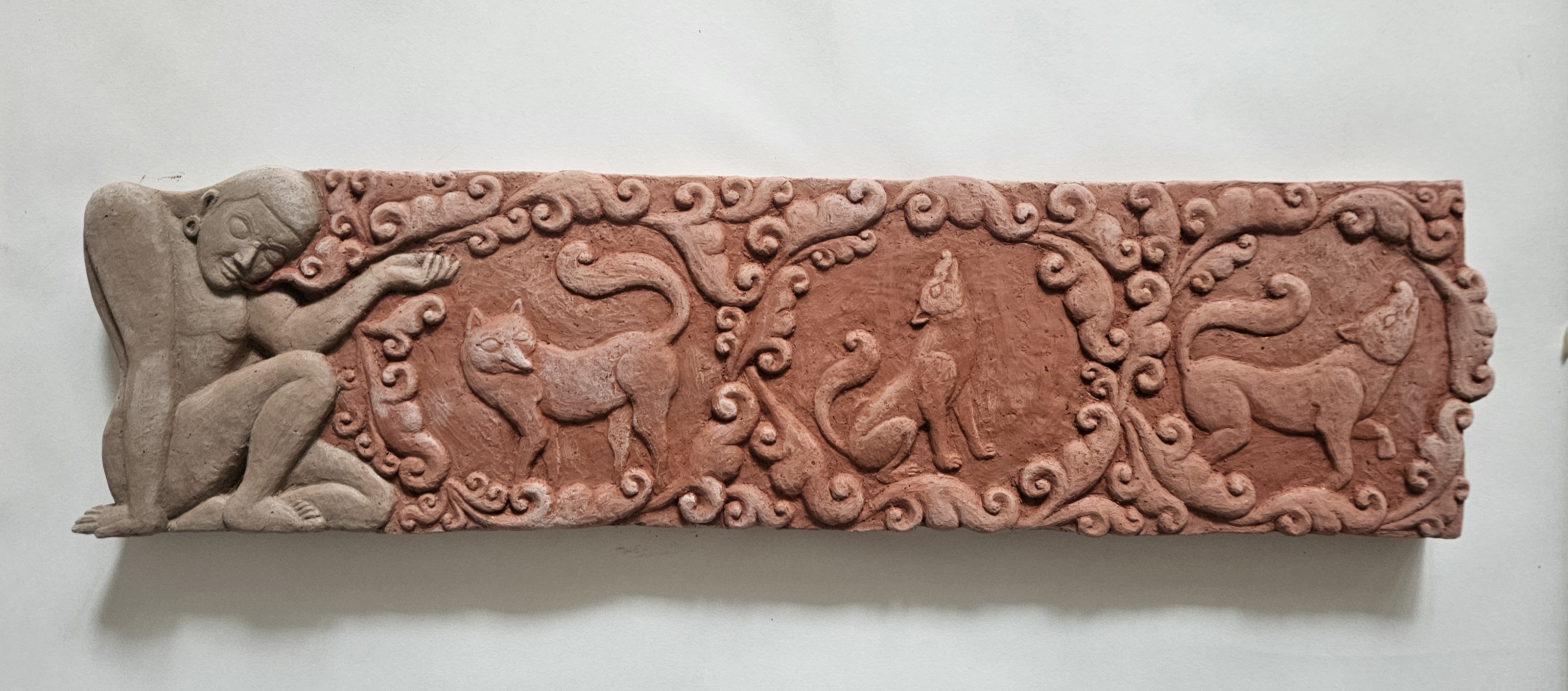Culture & Lifestyle
Stories that rest in the corners of home
At Takpa Gallery, ‘To Build a Shelter’ shows how landscapes, ancestors, and everyday objects keep the idea of home alive..JPG&w=900&height=601)
Sanskriti Pokharel
The exhibit ‘To Build a Shelter’ gathers the voices of young Nepali artists who reflect on what it means to belong, remember, and carry fragments of home.
The title, curated by Pooja Duwal, is simple yet has layers. A shelter is more than a roof over one’s head. It is the land we inherit, the objects that carry our memories, the stories passed down by ancestors, and the habits of everyday life.
In this group show, the idea of shelter takes many shapes. Some works return to the soil of one’s birthplace, others to the gestures of parents, or the hidden corners of a house. Collectively, they invite viewers to think about how we find safety and meaning in a restless world.
The exhibit unfolds through diverse media: printmaking, ceramics, embroidery, terracotta, and Paubha painting. This mix gives the gallery an atmosphere that is at once intimate and expansive. While some artists map the relationship between humans and animals, others revive forgotten household objects. Some trace inner landscapes, their motifs carrying emotions and symbols. Each work is different, yet all share the longing for connection and continuity.
.jpg)
One painting that draws attention is ‘The land will not be barren anymore’ by Samana Nachhiring Rai, a multidisciplinary artist based in Kathmandu. At first glance, it is a serene landscape of Ilam, her father’s homeland. The rolling tea gardens, cone-shaped trees, and layered hills glow under a soft wash of orange, like the last sunset light. The work radiates peace, as though the mountains themselves were breathing.
Yet when Rai speaks about the painting, its emotional depth reveals itself. “We worship nature and are connected to nature. Six months have gone by since my father passed away from cancer. I believe my father’s body is deep underneath the land, connected to nature. Hence, the land will not be barren now,” she says.
Her father’s presence in the soil of Ilam gives the painting its name and its soul. For Rai, painting the landscape became a way to return to her roots and find shelter in memory. Although she lives in Kathmandu for her studies and career, her art allows her to return to the village repeatedly. Through her brush, the hills of Ilam become both a personal refuge and a reminder of how land holds the weight of love and loss.
If Rai’s painting speaks in hushed tones, Purushottam Chaudhary’s canvases throb with raw colour and texture. Based in Kathmandu, Chaudhary completed his BFA at Lalitkala Fine Arts College. His series dedicated to his mother captures the hour of dusk. From a distance, the works appear as abstract red, blue, and black splashes. Up close, they reveal rough, gritty textures layered with emotion. One painting shows a space in shades of red, blue, yellow, and black, with a faint blue silhouette on the right. The figure, he says, is his mother.
“When I was a boy, I often waited for my mother to return from work, bringing me small snacks. That feeling of yearning as the dusk arrived made me anxious. Memories like these inspired me to see dusk as a time of return, belonging, and fragile comfort,” Chaudhary explains.
His use of materials carries meaning. The rough textures echo the unevenness of emotions, while fragile branches stand in for bones stripped of muscle. The blue figures and trees embody sadness and longing, and the red cuts through the surface like a reminder of tenderness, raw and exposed. What makes these paintings powerful is their openness. Viewers can stand before them and see fragments of their own stories reflected in the shifting hues of dusk.
Memory and heritage also shape the terracotta works of Shrayam Shakya, a visual artist who graduated from Kathmandu University. Growing up in the outskirts of Patan, he often heard stories of foxes that wandered near his home. Today, those foxes are gone, surviving only in memory. In his terracotta pieces, Shakya carves foxes alongside Yakṣa, the nature spirit linked with groundwater. Both motifs are deeply tied to his Newar heritage, where clay and terracotta play important roles in architecture and ritual.

“The oral traditions and stories of my ancestors become the remnant of the land and the existing knowledge. I merge these landscapes with Yakṣa, carrying the weight of the land and its history,” Shakya shares. For him, foxes and spirits are not just symbols. They are reminders of how fragile cultural memory can be, and how stories become shelters when the physical world changes. His clay surfaces feel alive with texture, as though they, too, are holding echoes of vanished landscapes.
While Shakya looks outward to cultural memory, artist Preeti Duwal turns inward to the overlooked corners of the home. A graduate of Kathmandu University’s School of Arts, she focuses on everyday objects that often escape attention, such as door handles, window grills, and folded newspapers tucked into latches. Her series, ‘Places where dust settles,’ is both humble and profound. Using clay in wooden frames, she recreates these objects with painstaking care.
“We often overlook these things. We don’t consider them important. These little things resonate home,” Duwal says. The process itself mirrors her theme. Working with clay is slow, fragile, and demanding. Each piece takes time to dry; the slightest mishap can cause cracks or breaks. Through this careful labour, Duwal elevates the ordinary. A simple door handle symbolises the countless hands that turn it, the daily routines that keep a household alive.
Her works speak of the unnoticed shelters we build without thinking, such as the leftover spaces, the corners where dust gathers, and the objects arranged and rearranged over the years. These subtle gestures, she suggests, are as meaningful as grand monuments. They, too, tell stories of care, survival, and continuity.
The works in ‘To Build a Shelter’ form a mosaic of memory and belonging. The exhibit succeeds not because it offers one definition of shelter, but because it reveals how many ways it can be built. A shelter may be a landscape, a mother’s embrace, an ancestral spirit, or a door handle polished by years of touch. Each artist, through their chosen medium, asks us to pause and notice where we find refuge in our own lives.
__
To Build a Shelter
Where: Takpa Gallery, Lazimpat
When: Until September 27
Time: Tuesday to Thursday 11 am to 6 pm, Friday to Sunday 11 am to 7 pm, closed on Monday
Entry: Free




 7.12°C Kathmandu
7.12°C Kathmandu













%20(1).jpg&w=300&height=200)

